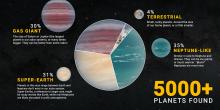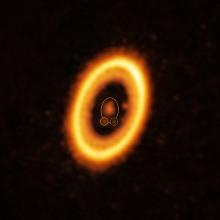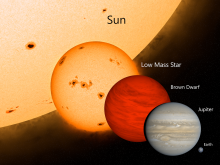Listen to today's episode of StarDate on the web the same day it airs in high-quality streaming audio without any extra ads or announcements. Choose a $8 one-month pass, or listen every day for a year for just $30.
You are here
Moon and Planets
The giants of the solar system form a wide, skinny triangle with the Moon in the wee hours of tomorrow. Jupiter, the largest planet, looks like a brilliant star to the left of the Moon. And fainter Saturn, the second-largest planet, is to the upper right of the Moon.
Today, Jupiter is five times farther from the Sun than Earth is, with Saturn almost twice that far. But that probably hasn’t always been the case. When the solar system was young, the planets may have moved much closer to the Sun, then back out again. That migration would have scattered the leftover “building blocks” of the planets — balls of ice and rock — kicking many of them out of the solar system. And a recent study suggested that Jupiter and Saturn could have kicked out another planet.
Calculating what might have happened requires complicated models and lots of computer power. But astronomers can find support for the idea that planets move around by looking at other star systems.
In fact, they’ve been tracking some planets known as “hot Jupiters” for years. They’re giant planets, like Jupiter. But they’re so close to their stars that they orbit in just days, making them quite hot. It’s likely that they were born farther out, then migrated inward. And long-term observations of several of them show that the planets continue to move closer to their stars. That shows that planets don’t always stay where they were born; sometimes, they like to move around.
Script by Damond Benningfield






